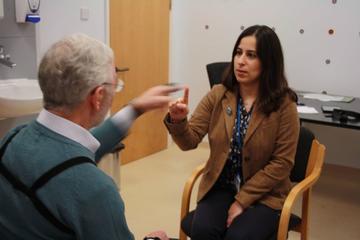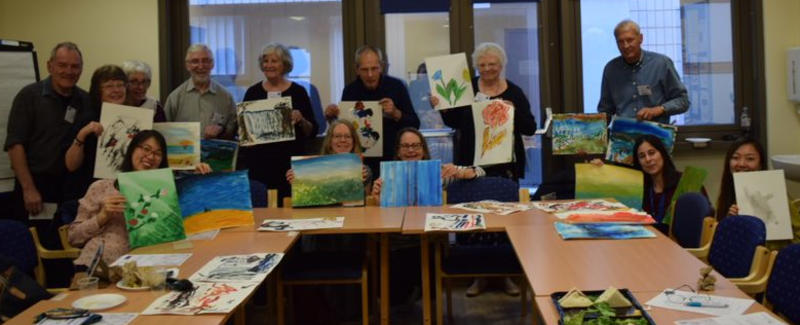‘If it wasn’t for my patients, I think I would have gone and become a gardener or a pilot.’ This statement from Professor Chrystalina Antoniades is not as random as it sounds: she is in fact qualified to fly me to Edinburgh in a small Cessna if I so desire. But she is not a professional pilot – she is an academic in the Nuffield Department of Clinical Neurosciences, one of the 16 departments in the University of Oxford’s Medical Sciences Division. So how did she get here?

Chrystalina interacting with one of her patients
Chrystalina arrived in Oxford for a period of six months – ten years ago. Originally from Cyprus, she completed a PhD at the University of Cambridge in neurodegenerative diseases. Upon its completion, Professor Christopher Kennard offered her a research post in clinical neurology at the University of Oxford, based in the John Radcliffe Hospital. It was here that she was eventually able to realise her dream of building a research group to study Parkinson’s disease.
Why Parkinson’s? During Chrystalina’s early adulthood, her grandmother was diagnosed with the condition. Chrystalina explains: ‘I remember thinking: goodness, the brain is such a bizarre thing. I really need to try and understand it.’ Her group is currently running a long-term clinical trial known as Oxford Quantification in Parkinson’s, or OxQUIP. Its purpose is to develop advanced technological methods for measuring the symptoms of Parkinson’s disease. Armed with this knowledge, clinicians can then understand more detail about a person’s experience of the disease and how it is progressing, which helps them to decide which patients should go into which drug trial.
‘I always wanted to measure things,’ says Chrystalina. ‘I loved maths as a kid.’ She and her team are monitoring patients’ eye movements to measure motor control and using questionnaires to assess cognitive problems. In this way they are ‘quantifying’ Parkinson’s, providing tools to give an accurate diagnosis. If patients are entered into drug trials that match their particular experience of Parkinson’s, this improves the chances of discovering better treatments for the condition. This is the essence of what Chrystalina describes as her particular piece of the Parkinson’s puzzle. But it is the interaction with patients that Chrystalina loves most. ‘I’m working for people, not numbers,’ she says.
One way in which this passion is manifested is in her public engagement work, which is built around the relationship between art and neuroscience. She grew up in a very artistic family and remembers many trips to museums in Greece and Cyprus. It’s not surprising, then, that her favourite place in Oxford is the Ashmolean Museum. It is here that she has organised several events for the annual Brain Awareness Week in March. These interactive stands, panel debates and mini exhibitions have drawn thousands of visitors over the years.

Participants in the Picturing Parkinson's project, with some of their artwork
Most recently, using money awarded from the University of Oxford’s Public Engagement with Research Seed Fund, she has been working with me on the Picturing Parkinson’s project. This project brings artists, neuroscientists and patients together to bridge the gap between the objective research into Parkinson’s and people’s lived experiences of the condition itself. We have organised a number of creative workshops for people living with the disorder, and their families. Most of these in-person and online events have been facilitated by Jan Sargeant, an artist living with Parkinson’s who signs her work ‘woman with stick’.
Picturing Parkinson's exhibition
In December we’re launching an online exhibition using a cutting-edge interactive platform called Kunstmatrix to showcase this work. We want people from all walks of life to take this opportunity to meet people who have a disorder that any one of us could have. This is a chance for everyone to hear the visions and voices of people who have a neurodegenerative condition, and to get an insight into their reality. Join our online launch on Thursday 2 December.